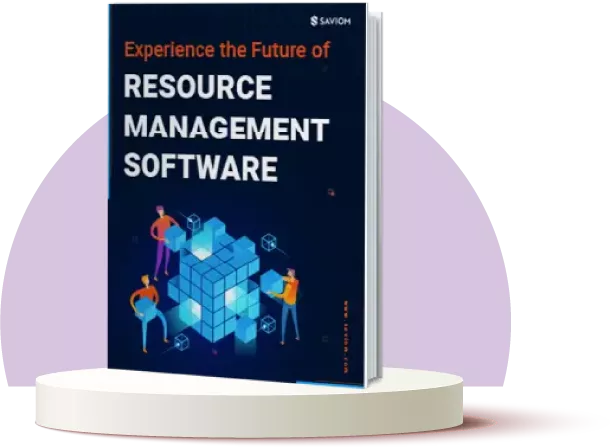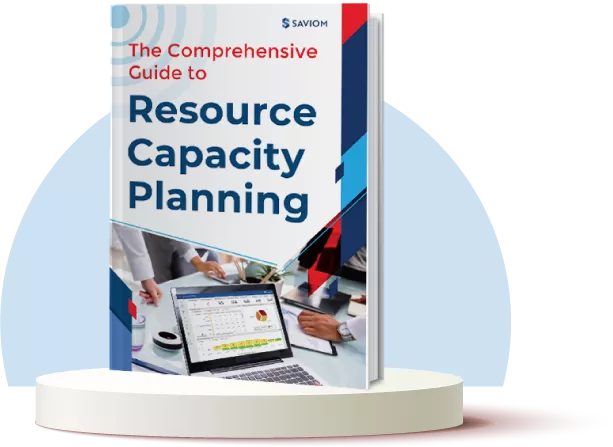Imagine this: you are a project manager at a growing IT firm, and project requests are coming in from all directions. The sales team has promised a quick turnaround for custom software, and the HR team has requested a new employee portal. Meanwhile, another client has sent a proposal for the Edtech platform. The result? Conflicting priorities, confusion, and overburdened developers.
To prevent this kind of chaos and ensure the right projects move forward, you need a well-defined project intake process. It acts as a strategic gatekeeper for capturing new project requests through a unified channel. This helps managers evaluate each request against clear business criteria and ensure only high-value, feasible initiatives move forward.
In addition, a structured intake process streamlines decision-making and fosters transparency and alignment across departments.
This blog will explain the project intake process, the primary challenges an organization would face without it, its advantages, and, in the end, strategies to make it better.
So, let’s start!
What is the Project Intake Process?
The project intake process is defined as the standardized flow of capturing, assessing, and managing new project requests. It typically begins with an intake form that collects essential details like the project scope, objectives, and resource needs. Once submitted, the request is reviewed against predefined criteria to assess its feasibility, alignment with organizational goals, and potential ROI.
Based on the assessment, managers can approve, defer, or reject the request. By establishing a clear project intake process, organizations can prioritize high-impact initiatives, prevent the overloading of resources, and eliminate pursuing low-value or redundant projects.
After the definition, let’s look at the intake process flow.
Phases of the Project Intake Process
The project intake process includes four main phases. Let’s have a look at them:
Request Submission
It is the first phase in the intake process, where the client, stakeholder, or project owner submits a formal request to the business. These requests are submitted through a project request form, email, phone call, or in person. A clear and complete submission lays the foundation for proper evaluation and prioritization of projects in the subsequent phase.
Project Review
This phase allows the evaluation of the request for viability, alignment with business objectives, and overall feasibility. This assessment helps understand whether the proposal is achievable and profitable. Additionally, the PMO assigns a prioritization score based on strategic fit, urgency, and value, which helps filter low-value or misaligned projects early.
Approval, Deferral, or Rejection
In this phase, management makes the final decision on each project request. The decision is based on resource availability, required skill sets, priority level, client needs, strategic alignment, etc. The approved projects move to the next phase, the rejected ones are given a valid reason, and deferred requests are reconsidered when time allows.
Project Initiation
The project initiation phase allows the selected initiatives to move from proposal to execution. For this, a project manager is assigned, and a charter is created to define the initiative’s purpose, objectives, high-level schedule, budget, etc. After that, the team is assembled, roles are clarified, and best-fit resources are allocated to ensure smooth project execution, laying a strong foundation for project success.
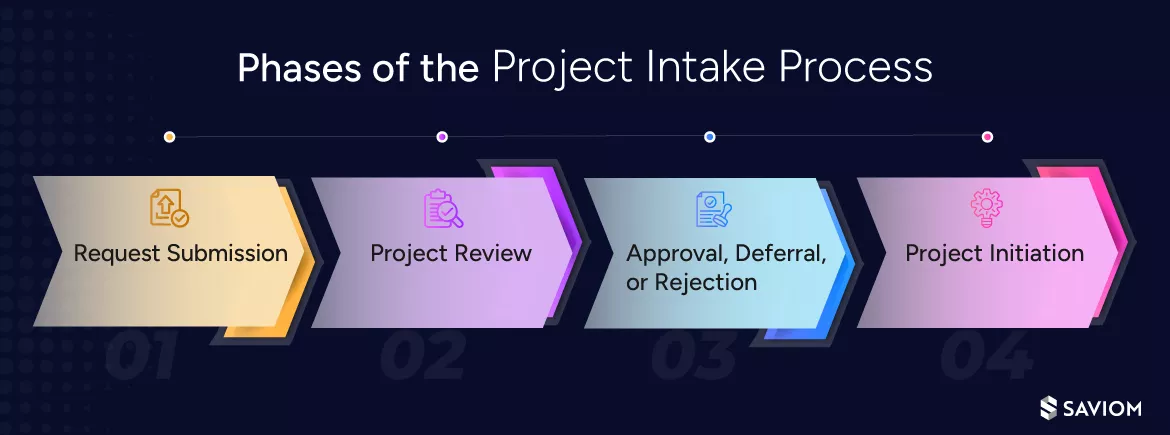
After exploring the intake process steps, let’s look at the key elements of the intake form.
Key Elements to Include a Project Intake Form
Below mentioned are the key elements of a project intake form:
Project Overview
The project overview serves as a quick introduction to the project request and enables stakeholders and sponsors to quickly grasp the scope and purpose. A well-crafted project overview includes a project name, a brief background of the opportunity or issue that led to the request, and a concise description of the proposed solution.
Business Case & Objectives
Next, the requester outlines the business case, stating why this project is needed and how it aligns with organizational goals. Here, they can include the objectives highlighting what the project tends to achieve, such as improving efficiency, reducing costs, generating more leads, etc.
Project Scope
This part defines the boundaries of a project, what it includes, and what it will not. It describes the project’s objectives, deliverables, tasks, deadlines, and expected outcomes. This clarity prevents scope creep and allows stakeholders to understand the overall needs. It also ensures realistic expectations from the initiation phase.
Cost-Benefit Analysis
This section compares the expected costs with the projected benefits to assess whether it is worth pursuing. It helps decision-makers estimate project ROI, potential cost savings, and revenue growth. The cost-benefit analysis also helps filter out low-impact proposals and ensure that only financially justifiable projects move forward.
Read More: What is Project ROI? 5 Essential Steps to Measure It
Estimated Timeline & Budget
Estimating a rough project duration and budget is crucial for accurate evaluation. This element allows managers to assess whether the project fits within current resource capacity, budget constraints, and delivery schedules or not. Thus, it helps flag projects with unrealistic timelines or low budgets early.
Stakeholders & Team Involved
Knowing who will be involved in the project is as important as understanding its purpose and scope. That’s why it is important to highlight the key project stakeholders, decision-makers, and team members in the intake form. Additionally, it should also list the roles and responsibilities of each member to ensure transparency and enhance collaboration.
Risks & Constraints
This component highlights risks and constraints that the project may face, including resource shortages, technical challenges, or regulatory issues. A preliminary risk assessment enables the review team to analyze whether the company can manage this risk adequately before moving forward.
Read More: What is Enterprise Risk Management? 9 Key Steps to Implement
By now, we have understood the project intake process, its phases, and the key components of the intake form. Now, let’s know the criteria for project intake.
Project Intake Criteria
The following things should be considered while evaluating the project request. Let’s have a look.
Strategic Alignment with Business Goals
In this criterion, the project objective is reviewed and assessed for its alignment with a business goal. The project’s value, outcome, and critical needs are also evaluated. A project that supports business objectives and growth is more likely to receive approval. Thus, this evaluation helps the firm prioritize impactful and profitable initiatives.
Project Scope & Duration
This criterion evaluates the scope to understand its scale, complexity, and primary project deliverables. It assesses the estimated time required to complete a project. Thus, it allows stakeholders to gauge feasibility, dependencies, potential delays and determine if the firm can commit necessary resources for the required timeline.
Cost-Benefit Analysis
In this criterion, the finance team evaluates whether the project’s financial and operational value is worth the effort and investment required. For this, the estimated cost is compared with projected benefits such as ROI, cost savings, and revenue growth. Projects with favorable cost-benefit ratios are usually prioritized; meanwhile, high-cost, low-return initiatives are deferred or rejected.
Read More: Understanding Cost Baseline in Project Management: Components, Benefits & Steps
Resource Requirement Estimation
This criterion helps estimate the full spectrum of resources (human and non-human) needed for timely project execution. It highlights all the required project resources their skills, expertise levels etc. Additionally, it outlines tools, machinery, and raw materials needed to support project activities. This ensures accurate resource requirements are captured to avoid instances of over-commitment.
Resource Availability & Capacity
In this criterion, future demand is assessed against current resource capacity by evaluating existing workloads and planned leaves. This helps determine if the organization can realistically support the new project without overburdening teams. Moreover, identifying potential capacity gaps early prevents projects that are likely to face execution delays due to resource shortage and unavailability.
Expected Project Profitability
It is one of the most significant criteria for project intake. This helps evaluate whether the project will likely generate sufficient financial return or strategic value for the organization or not. It involves estimating potential revenue, profit margins, cost savings, or long-term benefits. Thus, it helps prioritize projects that offer the highest return on investment and filter out low-value initiatives early.
Read More: What is Project ROI? 5 Essential Steps to Measure It
Compliance & Legal Requirements
Compliance and legal checks are critical in validating a project’s legitimacy and risk exposure before approval. Therefore, this criterion helps examine whether the proposed initiative fully adheres to all regulatory, safety, and company policies. It helps organizations avoid getting into legal trouble, prevent penalties, and safeguard their reputation.
Project Risk Assessment
This criterion focuses on identifying and assessing possible obstacles before starting a project. It evaluates project stability by examining technical, operational, or financial risks that the project might encounter. Risk assessment paves the way for approving low-risk projects first and reduces unforeseen disruptions.
Now, let’s understand the concept better with an example.
Project Intake Process Example
Imagine you are a manager of an IT company who received a project request for developing a custom CRM for the sales team. Here’s how a structured intake process unfolds step-by-step:
Step 1: Project Request Submission
The project initiator, such as the sales head, submits an intake form outlining key details such as project title, objectives, key features, expected deadlines, and desired outcomes. Relevant stakeholders fill out different sections of the document. For example, the finance team provides cost-benefit analysis data, and the project/resource manager inputs resource needs.
Step 2: Review by PMO or Intake Committee
After submission, the PMO or the intake committee reviews the form to ensure the data is complete and accurate. They validate the business case and confirm scope clarity.
Step 3: Prioritize & Evaluation
The request is then evaluated based on business value, strategic alignment, urgency, feasibility, risks, resource requirements, and estimated ROI. Based on this assessment, PMO assigns priority scores to the request. This helps decision-makers focus on high-priority initiatives.
Step 4: Approval or Rejection
After evaluations, the project management office (PMO) or intake committee presents the project brief, feasibility report, and cost estimates to senior management. Based on this, the project may be approved, approved with recommended changes, deferred for later considerations, or rejected with feedback.
Step 5: Allocation of Project Manager & Team
Once approved, a dedicated project manager and a suitable team are assigned to handle the execution. The manager creates a detailed project plan which includes objectives, milestones, budget, schedule, and resources.
Step 6: Kickoff Meeting with Stakeholders
Finally, a project kickoff meeting is conducted with key stakeholders, the PM, and the delivery team to align expectations, finalize the scope, and begin detailed planning for execution.
We have understood the definition of the intake process, its phases, criteria, and examples. Now, let’s learn the benefits of the project intake process.
Read More: What is PMO (Project Management Office): Roles, Responsibilities, Types & Benefits
Benefits of Effective Project Intake Processes
Here are the key benefits of an effective intake process in an organization. Let’s have a look at them in detail.
Establishes Clear Project Selection Criteria
An efficient intake process allows an organization to establish standard ways of evaluating each new project proposal. It guides all requests to have the same consistent format. This uniformity in data collection allows PMOs to evaluate and compare all project proposals using predefined benchmarks. As a result, only the most valuable and feasible projects get approved.
Improves Portfolio Visibility for Intelligent Prioritization
A well-structured intake process provides a centralized visibility of all initiatives, enabling stakeholders to understand the project portfolio better. This holistic perspective allows decision-makers to make well-informed choices regarding approval, delay, or rejection by comparing the strategic alignment, resource requirements, business impact, and urgency of different initiatives.
Read More: What is Project Portfolio Management and Why Is It Important?
Enables Smarter Resource Planning & Optimal Utilization
During the intake process, the resource requirements are outlined upfront. This allows managers to forecast resource demand accurately, identify shortages/excesses, and take corrective action. Moreover, managers can proactively allocate suitable people to the project according to their skills, availability, and workload, avoiding overbooking or resource underutilization.
Strengthens Cross-Functional Collaboration
The project intake process fosters cross-departmental collaboration by centralizing the process of submitting and reviewing project requests. It ensures that the diverse insights of teams like finance, IT, and operations are considered to make balanced and informed decisions. When all departments are involved from the beginning, conflicts are reduced, and projects are more likely to succeed.
Read More: 9 Effective Ways to Empower Cross-Functional Teams
Speeds Up Project Onboarding & Execution Readiness
With all the main information like schedule, scope, and required resources mentioned on the intake form, teams can start work sooner. This reduces delay caused by incomplete or unclear information and enhances readiness across teams. Moreover, project managers can proactively make training or hiring decisions for timely project execution instead of relying on guesswork.
These are the benefits of the project intake process. Let’s now head towards the challenges.
Challenges That Arise with New Project Requests
New project requests bring challenges along with opportunities. Below are a few commonly faced challenges:
High Volume of Simultaneous Requests
Without a systematic process, requests can come from anywhere, including mail, references, phone calls, and so on. The decision-makers find it difficult to properly assess and prioritize multiple initiatives when they come at once. Furthermore, a lack of visibility into the pipeline can lead to key projects being overlooked. This can disrupt the organization’s workflow and delay the approval of high-value projects.
Misalignment with Business Strategy
Not every project aligns with the company’s long-term goals or strategic business objectives. However, approving such misaligned requests can impact workforce planning, divert resources away from high-impact initiatives and reduce the overall business ROI. It also weakens the organization’s ability to stay focused and competitive, wasting effort and hampering growth.
Read More: What is Operational Workforce Planning and How it Benefit the Organizations?
Incomplete Project Information
When a project lacks critical information, such as objectives, scope, timelines, or resource needs, it becomes difficult for managers to assess and evaluate its feasibility and risks. This can lead to a lot of back-and-forth communication and a delay in decision-making. It can also result in confusion about the accurate project requirements, ultimately slowing down the entire intake and approval process.
Lack of Standard Evaluation Criteria
Without a uniform selection criterion for evaluating new requests, approvals become subjective and inconsistent. As a result, managers may prioritize and approve the wrong projects. This unorganized evaluation also makes it difficult for them to justify their decisions later. In addition, due to a lack of visibility into key information, the team may debate the project’s worth rather than execute it, leading to conflicts and delays.
Read More: 5 Project Selection Criteria to Structure the PMO
Duplicate or Redundant Initiatives
When there is no intake process in place, project requests can come from multiple sources, like different salespeople or stakeholders. Often, the same request is submitted more than once without anyone’s notice. As a result, teams may start working on duplicate requests, like the finance team doing a cost-benefit analysis on the same project twice. This leads to wasted time, duplicated effort, and confusion across departments.
Overcommitment & Under-delivery
Without a formal intake process, managers may approve more initiatives than the team can realistically handle, leading to over-commitment. This often leads to resource bottlenecks, missed project milestones, and compromised quality, jeopardizing project success. Moreover, consistent under-deliveries can also result in stakeholder dissatisfaction and reputational damage.
Read More: Project Milestones: How to Manage Them Effectively for Project Success?
After understanding the challenges, let’s learn how to create an effective project intake process.
How To Create an Effective Project Intake Process?
An efficient project intake procedure helps filter out low-value projects and ensures that only those aligned with business objectives move forward. Here’s a rundown of the steps to build an effective intake process:
Create a Standardized Intake Document
This is a critical step in building an effective project intake process. The intake document contains key information such as the overview, objectives, forecasted project budget, expected benefits, estimated timeline, and resource requirements. Thus, a standardized intake form allows managers to keep all the necessary information about the project together.
Moreover, it minimizes confusion, reduces unnecessary back-and-forth communication, and speeds up the evaluation process. To further improve accuracy and efficiency, a guidance document can be prepared that outlines how to complete the intake form correctly. This ensures that all stakeholders fill out the required information correctly and concisely.
Determine Roles and Responsibilities
Once the intake form is created, the next step is to define the roles and responsibilities for each part of the process. This includes defining the roles of people responsible for drafting the document, completing specific sections, and reviewing and validating the submitted information.
For example, the team lead may fill out project-specific details such as objectives, resource needs, and timelines, while the leadership in project management or PMO may be responsible for reviewing and validating the form. This clarity avoids delays, ensures faster evaluation, and ensures no request is missed or duplicated.
Read More: Leadership in Project Management: 10 Tips to Become a Good Leader
Establish Evaluation & Prioritization Criteria
After determining the role, managers can set clear prioritization and evaluation criteria for projects. For this, they can outline the parameters on which the upcoming project requests will be evaluated, such as project value, cost, resource requirement, business impact, and goal alignment.
Moreover, well-established evaluation criteria help decision-makers reduce bias. Besides, the manager can also consider using a decision matrix or a scoring system to make fair decisions. It is also important to maintain transparency so that all teams clearly understand the basis for project decisions.
Leverage a Project Intake Management Tool
Next, an organization can utilize a robust intake management tool to manage requests from start to finish. These tools simplify the process by creating a digital intake form, tracking status, and maintaining request history. Moreover, this ensures that all project requests are stored, organized, and accessible in one place.
Further, this centralized data provides visibility into the pending proposals, resource demand, and prioritization needs, ensuring that no requests are missed. For the best results, pick a user-friendly platform that improves cross-functional collaboration and supports integration with other tools.
Read More: How to Measure Resource Capacity and Demand
Communicate Approval or Rejection Decisions
Open and transparent communication is the key to a successful intake process. Once a project is approved, deferred, or rejected, the decision-makers or PMOs can communicate the outcome through standardized channels such as email, face-to-face meetings, or a project management tool.
Additionally, decision-makers can also provide a clear rationale for project rejection or deferral, whether it’s based on budget limitations, resource constraints, or lack of strategic alignment. This approach keeps everyone informed and helps requesters understand the reasoning, which enables them to align future projects accordingly.
Monitor & Optimize the Process Regularly
Finally, no method is ideal from the start. That’s why it’s essential to treat the project intake process as work in progress. To ensure this, the intake committee or PMO can consistently monitor the process by analyzing KPIs such as request turnaround time, approval rates, and project success rate.
Moreover, they can also collect feedback from department heads, reviewers, and requesters to identify any inefficiencies. Based on the feedback, they can modify the intake form, change approval roles, update scoring criteria, etc. Periodic reviews or retrospectives ensure that intake process remains aligned with organizational priorities.
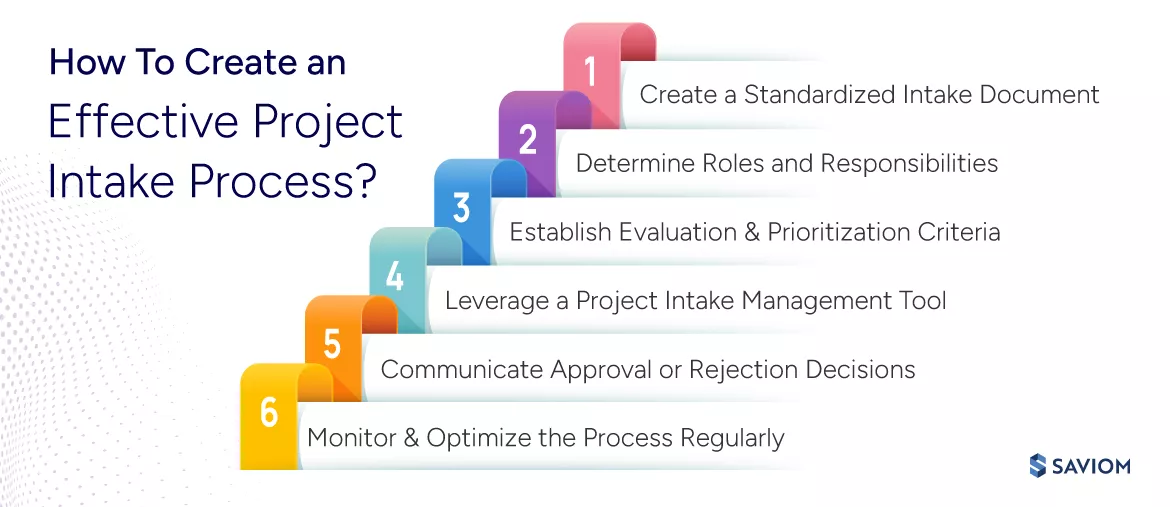
Read More: What are Project Deliverables? 6 Ways to Manage Them Effectively
After the strategy, let’s now understand how the 5th Gen resource management tool can help manage a firm’s project intake process.
How Can a 5th-Gen Resource Management Tool Enhance the Project Intake Process?
The intake process is an ongoing procedure that improves with the right tools and methods. Here is the advanced resource management software that helps you enhance your organization’s project intake process.
- The all-in-one resource planner assists managers in filtering resource data according to roles, locations, skills, and experience. This helps align requirements with resource availability to assess the project’s feasibility.
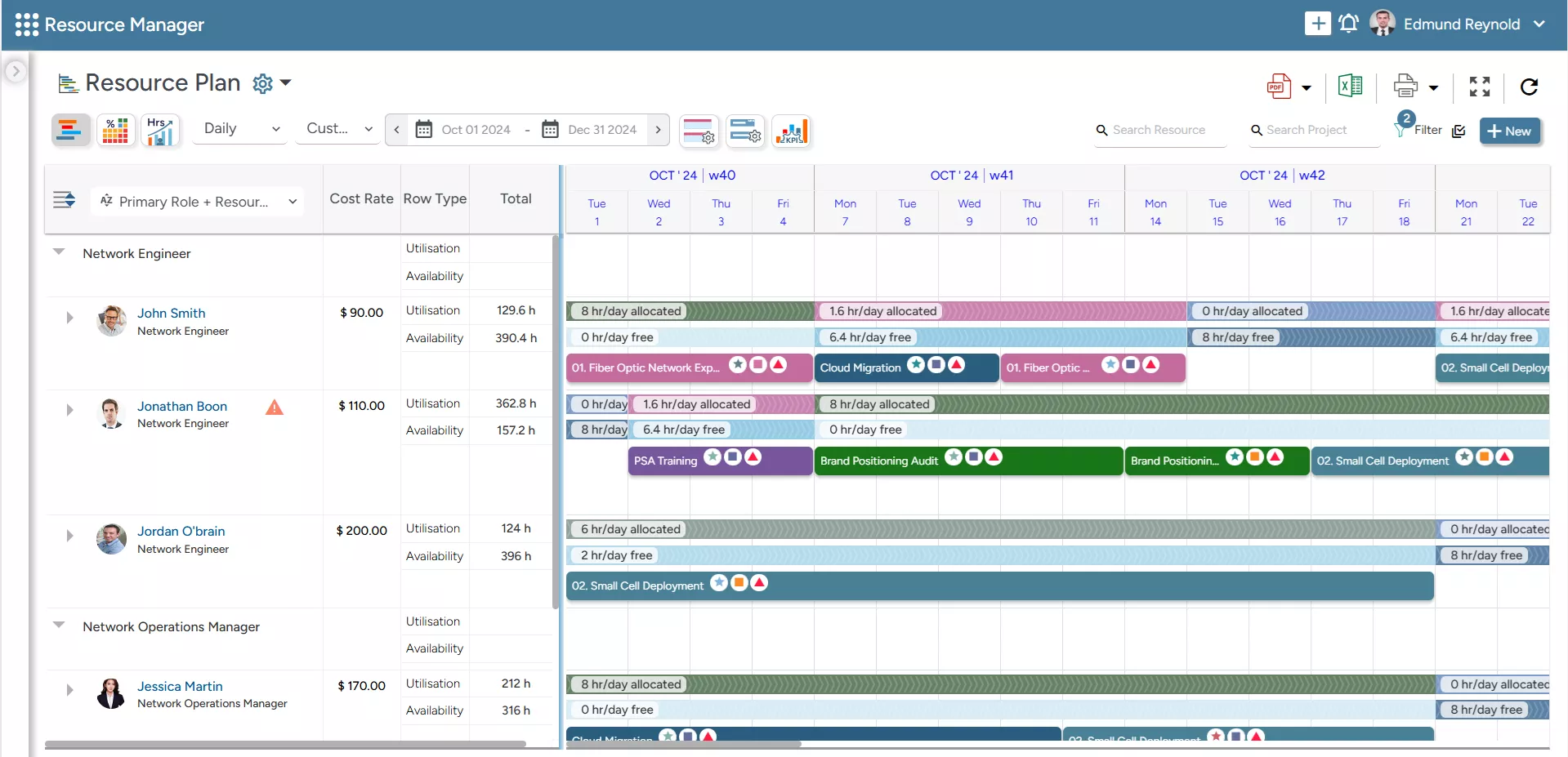
SAVIOM’s All-in-One Resource Planner offers 360-degree visibility of all resources, enabling managers to make informed decisions.
- With the help of the embedded capacity planning feature, the project intake team may analyze resource excesses and shortages beforehand during intake evaluations.
- The smart KPI forecaster offers early visibility into resource metrics such as utilization and availability to assess the feasibility of new project requests.
2. The real-time talent planning and competency matrix helps in identifying if the required skills are available for pipeline projects. This helps managers to plan upskilling and training programs beforehand.
3. Finally, the what-if analysis function enables the manager to simulate various resourcing scenarios and examine their impact before approving a project. It ensures that the chosen project is feasible, cost-effective, and sustainable.
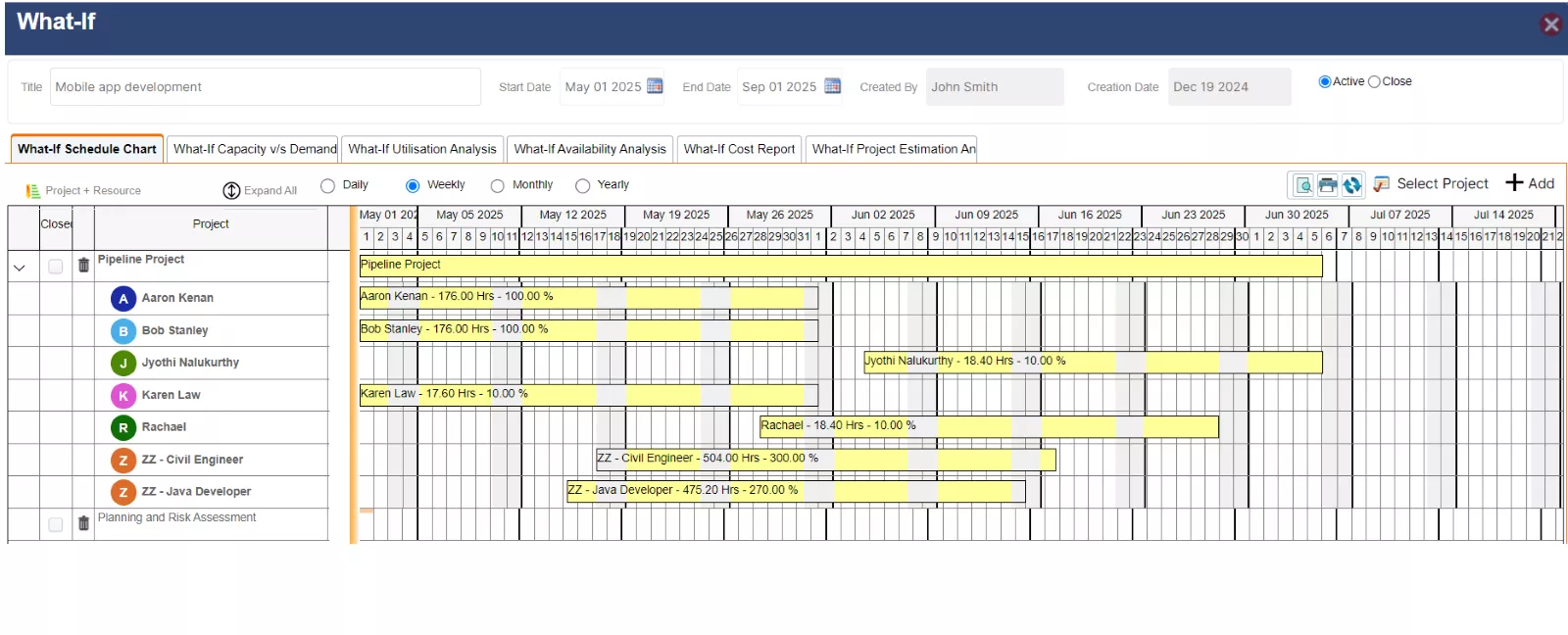
SAVIOM’s What-if Analysis feature allows managers to leverage scenario modeling in a sandbox environment to assess the impact of various decisions before finalizing the best-fit plan.
Conclusion
An effective intake process helps an organization to evaluate and take on new projects with clarity. It ensures that only high-impact, value-adding projects move forward. Moreover, a well-structured intake process improves visibility, enhances collaboration, and supports better resource planning. Furthermore, it reduces the risks of overcommitment, missed deadlines, and project failure. Overall, refining your intake process is key to driving business efficiency and long-term success.
So, how is the project intake process currently managed in your organization?
The Glossary
Read More: Glossary of Resource Workforce Planning, Scheduling and Management


